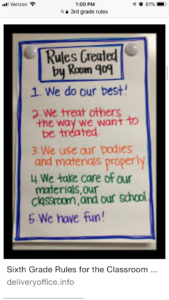Student Contributor: S. Dianda
 Rules are important to have in a classroom, but even more important is how the rules are presented. They are meant to create the classroom environment, and are created for a moral reason. If they are positively phrased, purposeful, and conceptual, they will be much more effective.
Rules are important to have in a classroom, but even more important is how the rules are presented. They are meant to create the classroom environment, and are created for a moral reason. If they are positively phrased, purposeful, and conceptual, they will be much more effective.
There are rules for making classroom rules. They are:
– Keep list brief
– Have students help create (if Student-Centered)
– Keep positively phrased
-Should be purposeful
-Should be clear and easy to understand (age appropriate)
-Review them periodically
-Keep them conceptual (ex: instead of “Don’t Kick”, say “Be Kind.”)
This tool relates to all three phases. It is a preventative tool, and if done right, will make the supportive phase much easier to maintain, and hopefully will minimized the actions needed to be taken in the corrective phase. This is a student-directed approach to teaching (especially the rule that says "have students help create", but rules are used in all classrooms, whether it is a teacher-centered class, collaborative, or student-directed class, so this measure can be helpful in any of the types of teaching in Theories of Influence. As I stated, this is a Student-centered approach, because it allows the students to take part in the making of the rules, and keeping them positively phrased goes along with that theory as well because we are trying to build a positive community in our classrooms.
More Information –
Tool Source: I got this idea from Gus Nollmeyer's class discussion on making classroom rules


